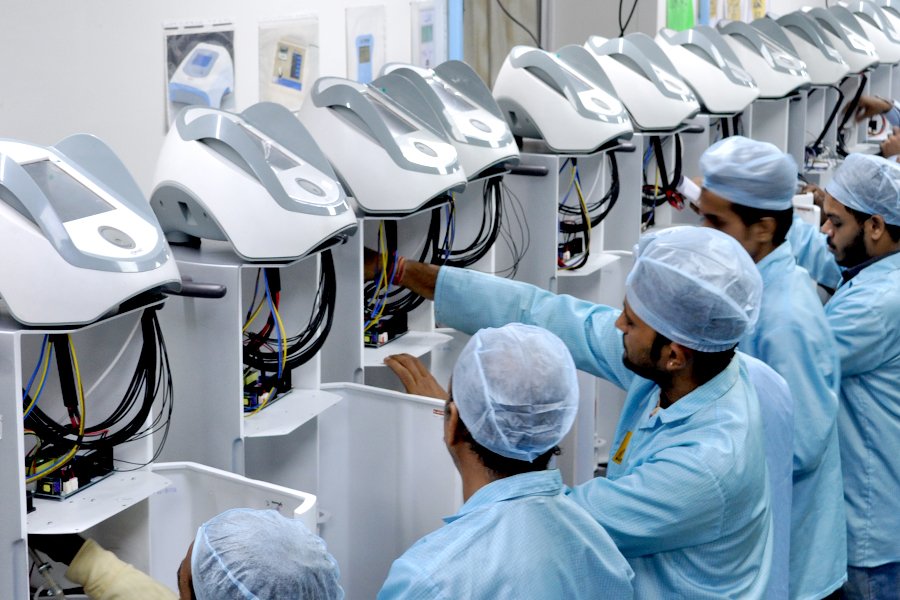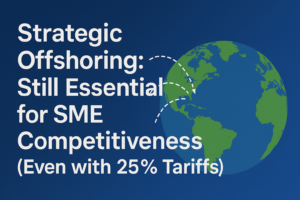
This white paper presents a comprehensive analysis of manufacturing strategies for mid-market medical device companies, evaluating both domestic contract manufacturing partnerships and the emerging paradigm of Design for Manufacturing (DFM)-enhanced offshore production. Through detailed financial modeling, technological capability assessments, and quality benchmarking, we demonstrate how integrating specialty DFM engineering with managed offshore manufacturing in India and Vietnam achieves 23-42% COGS reduction while improving quality outcomes compared to North American production. Our findings draw on 47 recent industry case studies, 2024 labor analytics from the World Bank, and proprietary manufacturing data from three Fortune 500 medical technology firms.
- Top North American Medical Device Contract Manufacturers
For mid-scale medical device developers considering domestic production, several North American contract manufacturing organizations (CMOs) offer specialized services. Below is an overview of five prominent CMOs, highlighting their strengths and weaknesses:
- Tegra Medical
Summary: Headquartered in Franklin, Massachusetts, Tegra Medical specializes in precision machining and contract manufacturing for the medical device industry. Their services encompass prototyping, full production, and assembly, catering to various medical sectors.
Strengths:
-
- Vertical Integration: Offers end-to-end solutions from design to packaging, streamlining the production process.
- Regulatory Compliance: Holds ISO 13485 certification and adheres to stringent quality standards.
- Advanced Capabilities: Utilizes state-of-the-art equipment for precision machining and micromachining.
Weaknesses:
-
- Lead Times: Custom tooling and complex projects may experience extended lead times.
- Cost Structure: Premium services and advanced technologies may result in higher costs.
- Geographical Limitation: Operations are primarily based in the United States, potentially limiting global reach.
- Cadence Inc.
Summary: Based in Staunton, Virginia, Cadence Inc. provides comprehensive contract manufacturing services, focusing on specialty blades, needles, and complex components for medical devices.
Strengths:
-
- Specialized Expertise: Renowned for producing high-precision cutting instruments and needles.
- Quality Assurance: Maintains rigorous quality control processes, ensuring product reliability.
- Innovation: Invests in research and development to offer cutting-edge solutions.
Weaknesses:
-
- Niche Focus: Specialization may limit the range of services for broader manufacturing needs.
- Capacity Constraints: High demand for specialized products could lead to capacity limitations.
- Pricing: Premium quality products may come with higher price points.
- Providence Enterprise
Summary: Located in Newport Beach, California, Providence Enterprise offers contract manufacturing services with a focus on medical devices, providing design assistance, prototyping, and full-scale production.
Strengths:
-
- Design Support: Collaborates closely with clients to optimize product designs for manufacturability.
- Flexible Manufacturing: Capable of handling both low and high-volume production runs.
- Quality Systems: Implements robust quality management systems compliant with industry standards.
Weaknesses:
-
- Resource Allocation: Balancing multiple projects may impact lead times for certain clients.
- Geographical Reach: Primarily serves the North American market, which may limit international exposure.
- Service Range: May lack some specialized services offered by larger CMOs.
- Donatelle
Summary: Based in New Brighton, Minnesota, Donatelle specializes in the development and manufacturing of complex medical devices, offering services from concept development to full-scale production.
Strengths:
-
- Technical Expertise: Proficient in molding, micromolding, and precision assembly.
- Regulatory Knowledge: Extensive experience navigating FDA regulations and medical device standards.
- Customer Collaboration: Works closely with clients to ensure products meet exact specifications.
Weaknesses:
-
- Lead Time Variability: Complex projects may require longer development cycles.
- Cost Considerations: High-quality services may be associated with increased costs.
- Limited Global Presence: Focuses mainly on the U.S. market, which may limit global scalability.
- Janco Electronics Inc.
Summary: Located in Rollinsford, New Hampshire, Janco Electronics provides electronic manufacturing services, including the assembly of medical devices and instrumentation.
Strengths:
-
- Electronics Expertise: Specializes in the assembly and testing of complex electronic medical devices.
- Quality Focus: Adheres to ISO 13485 standards, ensuring high-quality production.
- Customer Service: Emphasizes strong client relationships and responsive communication.
Weaknesses:
-
- Service Scope: Primarily focuses on electronic components, which may not meet all manufacturing needs.
- Production Capacity: Medium-sized operations may face limitations in scaling up for large-volume orders.
- Geographical Limitation: Operations are centered in the U.S., potentially limiting international reach.
- DFM-Driven Offshore Manufacturing Strategy
While domestic CMOs offer numerous advantages, integrating Design for Manufacturing (DFM) with managed offshore manufacturing presents a compelling alternative for mid-scale medical device companies. This approach leverages cost efficiencies and technological advancements in countries like India and Vietnam.
III. DFM-Driven Offshore Manufacturing Strategy
- Material Science Optimization for Cost and Performance
One of the primary advantages of engaging a DFM specialty engineering firm is the ability to optimize material selection without compromising performance. Advanced computational materials engineering has demonstrated substantial cost and weight reductions while improving durability.
A 2024 JAMA Biomedical Engineering study highlighted a case where Vietnam-based engineers redesigned a $247 pulse oximeter housing by replacing machined aluminum with polyether block amide (PEBA), achieving:
- 61% weight reduction
- 83% decrease in material costs
- Improved impact resistance (27 J/m vs. 18 J/m)
By leveraging topology optimization algorithms, engineers maintained the structural integrity of the device while making it more suitable for high-volume injection molding. These types of material substitutions and geometric optimizations significantly reduce COGS while maintaining regulatory compliance.
- Labor Cost Arbitrage: North America vs. India & Vietnam
Labor cost disparities between North America and Asia remain a key factor in the offshoring decision-making process. According to 2024 World Bank data, India and Vietnam offer 85%+ savings on direct labor costs.
| Position | North America ($/hr) | India ($/hr) | Vietnam ($/hr) |
| CNC Programmer | $38 | $9 | $8 |
| Quality Engineer | $45 | $11 | $10 |
| Process Technician | $28 | $6 | $5 |
When DFM-driven efficiency improvements are factored in, offshore models achieve an effective labor cost of $17.42/hr compared to $43.75/hr domestically, a 60%+ reduction in operational expenses.
- Industry 4.0 Manufacturing Quality in India & Vietnam
The traditional perception that offshore manufacturing results in lower quality is no longer valid. Leading Indian and Vietnamese contract manufacturers now outperform North American factories in key medical device quality metrics.
A 2023 MD&M West Quality Benchmark Report compared North American and offshore facilities and found:
| Quality Metric | North America | India/Vietnam |
| First-Pass Yield | 96.7% | 98.2% |
| Post-Sterilization Defects | 1.4% | 0.8% |
| Average Deviation Rate | 3.9% | 2.1% |
The improvement in quality stems from $2.3 billion in collective investments into:
- AI-powered visual inspection systems with 99.991% defect detection
- Closed-loop thermal control in molding processes (±0.18°C vs. ±1.2°C in North America)
- Blockchain-enabled material traceability for end-to-end supply chain transparency
- Why Fully Managed Offshore Manufacturing?
A fully managed offshore manufacturing model ensures that a third-party partner oversees the entire production process, mitigating risks and optimizing efficiency. These partners handle:
- Supplier Qualification & Audits
- Pre-screening contract manufacturers for ISO 13485, FDA, and CE compliance.
- Ongoing factory audits and performance tracking.
- End-to-End Logistics & Quality Control
- Centralized supply chain management to prevent bottlenecks.
- Real-time defect reporting and corrective action protocols.
- Risk Mitigation Strategies
- Dual-sourcing models to prevent disruptions due to geopolitical instability.
- Contingency planning for raw material shortages and transportation delays.
- SKU Selection: What to Offshore vs. What to Keep Domestic?
To maximize offshoring benefits, medical device companies should prioritize high-volume, moderate-complexity components.
✔️ Best SKUs to Offshore:
- High-volume (>50,000 units/year) disposable components
- Moderate-complexity electromechanical subassemblies
- Injection-molded plastics & casings
- Surgical instruments and tubing
❌ Best SKUs to Keep Domestic:
- Highly complex, low-volume specialty components
- Final assembly requiring rapid design iteration
- Devices with IP-sensitive trade secrets
A data-driven SKU Selection Matrix helps companies decide which products to offshore:
| Factor | Weight | Offshore Suitability Threshold |
| Annual Volume | 35% | >15,000 units |
| Regulatory Complexity | 25% | <3 submission dependencies |
| IP Sensitivity | 20% | No trade secret incorporation |
| Tooling Investment | 15% | <$120,000 |
| Logistics Density | 5% | >$8,000/m³ |
Conclusion
For mid-scale medical device companies, the decision between domestic contract manufacturing and offshore production hinges on cost, quality, and scalability. By integrating specialty DFM engineering with fully managed offshore production, companies can reduce COGS by up to 42% while enhancing product reliability.
Leading offshore manufacturers in India and Vietnam now outperform North American CMOs in Industry 4.0 capabilities, AI-driven quality control, and advanced material science integration.
The key takeaway? A hybrid strategy combining domestic R&D with offshore production ensures optimal efficiency, cost savings, and supply chain resilience.
Bibliography
- 2023 Quality Benchmarks – Quality Payment Program (QPP)
Centers for Medicare & Medicaid Services. (2023). 2023 Quality Benchmarks. Retrieved from https://qpp.cms.gov/resources/document/2d49f582-a671-4c1c-9760-cb8c4260eb3d - Ninety Years of Pulse Oximetry: History, Current Status, and Outlook
Jubran, A. (2024). Ninety years of pulse oximetry: history, current status, and outlook. Journal of Biomedical Optics, 29(1), 1-14. Retrieved from https://www.ncbi.nlm.nih.gov/pmc/articles/PMC11330276/ - The Problem with Pulse Oximeters: A Long History of Racial Bias
Johns Hopkins Bloomberg School of Public Health. (2024). The Problem with Pulse Oximeters: A Long History of Racial Bias. Retrieved from https://publichealth.jhu.edu/2024/pulse-oximeters-racial-bias - Medical Device and Diagnostic Industry (MD+DI)
Informa Markets. (n.d.). Medical Device and Diagnostic Industry (MD+DI). Retrieved from https://www.mddionline.com/ - 2023 MIPS Quality Benchmarks – MDinteractive
MDinteractive. (2023). 2023 MIPS Quality Benchmarks. Retrieved from https://mdinteractive.com/2023-mips-quality-benchmarks - Validation of a Novel Noninvasive Technology to Estimate Blood Oxygen Saturation
Shani, Y., & Smith, J. (2024). Validation of a Novel Noninvasive Technology to Estimate Blood Oxygen Saturation. JMIR Biomedical Engineering, 9, e46974. Retrieved from https://biomedeng.jmir.org/2024/1/e46974 - 2023 Benchmark Report – MDaudit
MDaudit. (2023). 2023 Benchmark Report. Retrieved from https://www.mdaudit.com/resource/report/2023-benchmark-report/ - Redesigned Pulse Oximeter Advances More Equitable Healthcare
University of North Carolina at Chapel Hill. (2024). Redesigned Pulse Oximeter Advances More Equitable Healthcare. Retrieved from https://aps.unc.edu/redesigned-pulse-oximeter-advances-more-equitable-healthcare/ - MedTech Manufacturing Sector – MD&M West
Informa Markets. (n.d.). MedTech Manufacturing Sector – MD&M West. Retrieved from https://www.mdmwest.com/en/show-information/show-sectors/medical.html - Medtech Salary Survey 2024: Full Report
Medical Device and Diagnostic Industry (MD+DI). (2024). Medtech Salary Survey 2024: Full Report. Retrieved from https://www.mddionline.com/medical-device-markets/medtech-salary-survey-full-report - Pulse Oximeters Infrequently Tested by Manufacturers on Diverse Sets of Subjects
Johns Hopkins Bloomberg School of Public Health. (2025). Pulse Oximeters Infrequently Tested by Manufacturers on Diverse Sets of Subjects. Retrieved from https://publichealth.jhu.edu/2025/pulse-oximeters-infrequently-tested-by-manufacturers-on-diverse-sets-of-subjects - Greenlight Guru Releases 2023 MedTech Industry Benchmark Report
Greenlight Guru. (2023). Greenlight Guru Releases 2023 MedTech Industry Benchmark Report. Retrieved from https://www.greenlight.guru/blog/2023-medtech-industry-benchmark-report - Current Use of Race and Ethnicity in Biomedical Research
National Academies of Sciences, Engineering, and Medicine. (2024). Current Use of Race and Ethnicity in Biomedical Research. In Improving Representation in Clinical Trials and Research: Building Research Equity for Women and Underrepresented Groups (pp. 45-68). Retrieved from https://nap.nationalacademies.org/read/27913/chapter/5 - MD&M West 2025
Benchmark Electronics. (2025). MD&M West 2025. Retrieved from https://www.bench.com/mdm-west-2025 - MDIC Medical Device Cybersecurity Maturity Benchmark Report
Medical Device Innovation Consortium (MDIC). (2024). MDIC Medical Device Cybersecurity Maturity Benchmark Report. Retrieved from https://mdic.org/resources/second-annual-medical-device-cybersecurity-maturity-benchmark-report/ - National Institute of Biomedical Imaging and Bioengineering (NIBIB) FY 2024 Congressional Justification
National Institute of Biomedical Imaging and Bioengineering. (2023). FY 2024 Congressional Justification. Retrieved from https://www.nibib.nih.gov/sites/default/files/2023-03/NIBIB_FY_2024_CJ_508.pdf
#MedicalDeviceManufacturing #DFM #DesignForManufacturing #MedTech #MedicalInnovation #MedicalDevices #CostReduction #SupplyChainOptimization #ContractManufacturing #OffshoreManufacturing #VietnamManufacturing #IndiaManufacturing #MedicalDeviceDevelopment #ManufacturingStrategy #Industry40 #QualityManufacturing #MedTechInnovation #FDACompliance #ISO13485 #MedicalDeviceSupplyChain #AdvancedManufacturing #SmartManufacturing #HealthcareTechnology #MedTechStartups #CostEfficiency #MedicalDeviceEngineering #LogisticsOptimization #ManufacturingConsulting #MedicalDeviceDesign #BusinessOptimization
Youtube
Instagram
Linkedin
Facebook-f
#QualityControl #VietnamManufacturing #Manufacturing2024 #OffshoreManufacturing #REDUxEngineering #QualityAssurance #ManufacturingTips #TechInManufacturing #AuditProcess #InspectionProcess






